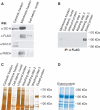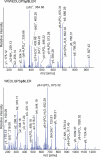Homologous desensitization of guanylyl cyclase A, the receptor for atrial natriuretic peptide, is associated with a complex phosphorylation pattern
- PMID: 20456499
- PMCID: PMC2901513
- DOI: 10.1111/j.1742-4658.2010.07658.x
Homologous desensitization of guanylyl cyclase A, the receptor for atrial natriuretic peptide, is associated with a complex phosphorylation pattern
Abstract
Atrial natriuretic peptide (ANP), via its guanylyl cyclase A (GC-A) receptor and intracellular guanosine 3',5'-cyclic monophosphate production, is critically involved in the regulation of blood pressure. In patients with chronic heart failure, the plasma levels of ANP are increased, but the cardiovascular actions are severely blunted, indicating a receptor or postreceptor defect. Studies on metabolically labelled GC-A-overexpressing cells have indicated that GC-A is extensively phosphorylated, and that ANP-induced homologous desensitization of GC-A correlates with receptor dephosphorylation, a mechanism which might contribute to a loss of function in vivo. In this study, tandem MS analysis of the GC-A receptor, expressed in the human embryonic kidney cell line HEK293, revealed unambiguously that the intracellular domain of the receptor is phosphorylated at multiple residues: Ser487, Ser497, Thr500, Ser502, Ser506, Ser510 and Thr513. MS quantification based on multiple reaction monitoring demonstrated that ANP-provoked desensitization was accompanied by a complex pattern of receptor phosphorylation and dephosphorylation. The population of completely phosphorylated GC-A was diminished. However, intriguingly, the phosphorylation of GC-A at Ser487 was selectively enhanced after exposure to ANP. The functional relevance of this observation was analysed by site-directed mutagenesis. The substitution of Ser487 by glutamate (which mimics phosphorylation) blunted the activation of the GC-A receptor by ANP, but prevented further desensitization. Our data corroborate previous studies suggesting that the responsiveness of GC-A to ANP is regulated by phosphorylation. However, in addition to the dephosphorylation of the previously postulated sites (Ser497, Thr500, Ser502, Ser506, Ser510), homologous desensitization seems to involve the phosphorylation of GC-A at Ser487, a newly identified site of phosphorylation. The identification and further characterization of the specific mechanisms involved in the downregulation of GC-A responsiveness to ANP may have important pathophysiological implications.
Figures






Similar articles
-
Protein kinase C-dependent desensitization of the atrial natriuretic peptide receptor is mediated by dephosphorylation.J Biol Chem. 1994 May 20;269(20):14636-42. J Biol Chem. 1994. PMID: 7910166
-
A constitutively "phosphorylated" guanylyl cyclase-linked atrial natriuretic peptide receptor mutant is resistant to desensitization.Mol Biol Cell. 1999 Jun;10(6):1811-20. doi: 10.1091/mbc.10.6.1811. Mol Biol Cell. 1999. PMID: 10359598 Free PMC article.
-
Homologous and lysophosphatidic acid-induced desensitization of the atrial natriuretic peptide receptor, guanylyl cyclase-A, in MA-10 leydig cells.Endocrinology. 2006 Jun;147(6):2974-85. doi: 10.1210/en.2006-0092. Epub 2006 Mar 9. Endocrinology. 2006. PMID: 16527839
-
Regulation and therapeutic targeting of peptide-activated receptor guanylyl cyclases.Pharmacol Ther. 2011 Apr;130(1):71-82. doi: 10.1016/j.pharmthera.2010.12.005. Epub 2010 Dec 24. Pharmacol Ther. 2011. PMID: 21185863 Free PMC article. Review.
-
Guanylyl cyclase / atrial natriuretic peptide receptor-A: role in the pathophysiology of cardiovascular regulation.Can J Physiol Pharmacol. 2011 Aug;89(8):557-73. doi: 10.1139/y11-054. Epub 2011 Aug 4. Can J Physiol Pharmacol. 2011. PMID: 21815745 Free PMC article. Review.
Cited by
-
Active propagation of dendritic electrical signals in C. elegans.Sci Rep. 2019 Mar 5;9(1):3430. doi: 10.1038/s41598-019-40158-9. Sci Rep. 2019. PMID: 30837592 Free PMC article.
-
A cardiac pathway of cyclic GMP-independent signaling of guanylyl cyclase A, the receptor for atrial natriuretic peptide.Proc Natl Acad Sci U S A. 2011 Nov 8;108(45):18500-5. doi: 10.1073/pnas.1103300108. Epub 2011 Oct 25. Proc Natl Acad Sci U S A. 2011. PMID: 22027011 Free PMC article.
-
Endothelial actions of atrial natriuretic peptide prevent pulmonary hypertension in mice.Basic Res Cardiol. 2016 Mar;111(2):22. doi: 10.1007/s00395-016-0541-x. Epub 2016 Feb 24. Basic Res Cardiol. 2016. PMID: 26909880 Free PMC article.
-
The pseudokinase domain in receptor guanylyl cyclases.Methods Enzymol. 2022;667:535-574. doi: 10.1016/bs.mie.2022.03.046. Epub 2022 Apr 18. Methods Enzymol. 2022. PMID: 35525553 Free PMC article. Review.
-
Feedforward and feedback mechanisms cooperatively regulate rapid experience-dependent response adaptation in a single thermosensory neuron type.Proc Natl Acad Sci U S A. 2024 Apr 2;121(14):e2321430121. doi: 10.1073/pnas.2321430121. Epub 2024 Mar 26. Proc Natl Acad Sci U S A. 2024. PMID: 38530893 Free PMC article.
References
-
- Kuhn M. Structure, regulation, and function of mammalian membrane guanylyl cyclase receptors, with a focus on guanylyl cyclase-A. Circ Res. 2003;93:700–709. - PubMed
-
- John SW, Krege JH, Oliver PM, Hagaman JR, Hodgin JB, Pang SC, Flynn TG, Smithies O. Genetic decreases in atrial natriuretic peptide and salt-sensitive hypertension. Science. 1995;267:679–681. - PubMed
-
- Lopez MJ, Wong SK, Kishimoto I, Dubois S, Mach V, Friesen J, Garbers DL, Beuve A. Salt-resistant hypertension in mice lacking the guanylyl cyclase-A receptor for atrial natriuretic peptide. Nature. 1995;378:65–68. - PubMed
-
- Holtwick R, van Eickels M, Skryabin BV, Baba HA, Bubikat A, Begrow F, Schneider MD, Garbers DL, Kuhn M. Pressure-independent cardiac hypertrophy in mice with cardiomyocyte-restricted inactivation of the atrial natriuretic peptide receptor guanylyl cyclase-A. J Clin Invest. 2003;111:1399–1407. - PMC - PubMed
-
- Kilic A, Velic A, De Windt LJ, Fabritz L, Voss M, Mitko D, Zwiener M, Baba HA, van Eickels M, Schlatter E, et al. Enhanced activity of the myocardial Na+/H+ exchanger NHE-1 contributes to cardiac remodeling in atrial natriuretic peptide receptor-deficient mice. Circulation. 2005;112:2307–2317. - PubMed
Publication types
MeSH terms
Substances
LinkOut - more resources
Full Text Sources
Molecular Biology Databases
Miscellaneous

